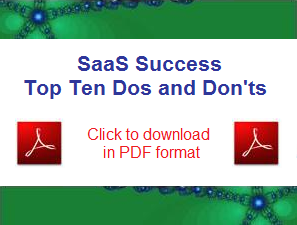
Save it or share it with a colleague.
Click the image above to download the SaaS Top Ten PDF.
For more SaaS business strategy tips,visit or subscribe to Chaotic Flow by Joel York
Or, click below to read the SaaS Top Ten Dos and Don'ts online...
SaaS Do #1 - Choose a Large Market
SaaS Do #2 - Create a Hub on the Web
SaaS Do #3 - Accelerate Organic Growth
SaaS Do #4 - Craft a Compelling Story
SaaS Do #5 - Build the Business into the Product
SaaS Do #6 - Reach across the Firewall
SaaS Do #7 - Monetize Creatively
SaaS Do #8 - Enable Mass Customization
SaaS Do #9 - Open Up to the Cloud
SaaS Do #10 - Leverage Your Community
SaaS Don't #1 - Chase Elephants
SaaS Don't #2 - Waste Money Marketing Offline
SaaS Don't #3 - Launch without Online Trial
SaaS Don't #4 - Cover up Shortcomings with People
SaaS Don't #5 - Invest in Channel Partners too Early
SaaS Don't #6 - Bleed Cash Indefinitely
SaaS Don't #7 - Ignore the Long Tail
SaaS Don't #8 - Think You Can Control It
Software-as-a-Service
Success
The Top Ten Dos and Don’ts of SaaS Business Success
Everyone is talking about computing on the cloud. Technology marketers are scrambling to ride the wave and recast their SaaS applications as cloud computing. But, don’t let the hype blind you to the very real, disruptive technology shift that is occuring, or to the concrete steps necessary to take advantage of it—and not get trampled by it. Software interacts with three things: people, hardware and other software. The SaaS revolution has been about reducing costs by aggregating remote and dispersed groups of people over the Web—software interacting with people to lower TCO. The disruptive shift called cloud computing is about the computers talking to each other over the Web—software interacting with other software, and thereby other hardware.
Just as you should reach out to your prospects over the Web to drive demand, now you must reach out to complementary applications on the Web to complete your offering, because your product will not be able to stand on its own. It must fit into the myriad ecosystems of applications and application components that form the basis of each customer’s unique computing environment. Only applications with extensive, open, standards-based APIs will survive, because customers will expect your application to slip seamlessly and effortlessly into their environments.
Is your software-as-a-service Web-aware and cloud friendly? Do you have an open, standards-based approach to integration built on a Web services framework? Have you created partnerships with companies that offer complementary applications? Do you natively support RSS and widgets? Are you actively cultivating a developer community and crowd-sourcing extensions and mash-ups? Where you should focus your investments in the cloud will depend on the nature of your business. But, any SaaS application that attempts to live in isolation or keep its customers inside a walled garden limits its value by depriving itself of the very network that has fueled its innovation and it will die from lack of nourishment.